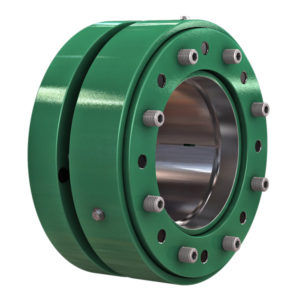
Rigid coupling FKH series frictionshaftflange
Add to favorites
Compare this product
Characteristics
- Type
- rigid, friction
- Product applications
- shaft, flange, gearbox
- Performance
- backlash-free
- Other characteristics
- torque, dry
- Torque
Min.: 6,000 Nm
(4,425.3729 ft.lb)Max.: 2,500,000 Nm
(1,843,905.37319 ft.lb)
Description
The main function of a hydraulic flange coupling (in the following called FKH) is the safe connection of two shafts. For example between a drive shaft and a gearbox shaft. The FKH creates a rigid and backlash-free connection between the shafts. This type of connection is mainly used to transmit torque, but can also absorb bending moments. The FKH is in the power flow.
The assembly is carried out by pushing the FKH onto the shaft and then clamping it with the hydraulic system. By using conical surfaces the inner diameter is reduced and the radial pressure is built up. After clamping is completed, the FKH is mechanically blocked and the hydraulic pressure is released. This simple procedure makes the FKH suitable for repetitive clamping processes.
Advantages of the FKH:
- high transmittable torsional and bending moments (high coefficient of friction)
- application-specific design/adaptation
- easy assembly and adjustment due to clearance fit
- relatively low pressure (closed system)
- quick clamping and releasing
- simple design (simple cone)
- short installation length
- can also be used for shafts with keyway (should be filled)
- combination of different shaft diameters
For proper function and to achieve a sufficiently high coefficient of friction, the contact surfaces between shaft and FKH must be free of grease, dry and clean. The functional surfaces of the FKH are provided with lubricant ex works.
Catalogs
No catalogs are available for this product.
See all of TAS-Schäfer GmbH‘s catalogs*Prices are pre-tax. They exclude delivery charges and customs duties and do not include additional charges for installation or activation options. Prices are indicative only and may vary by country, with changes to the cost of raw materials and exchange rates.







